Australia Prefabricated Buildings Market Size
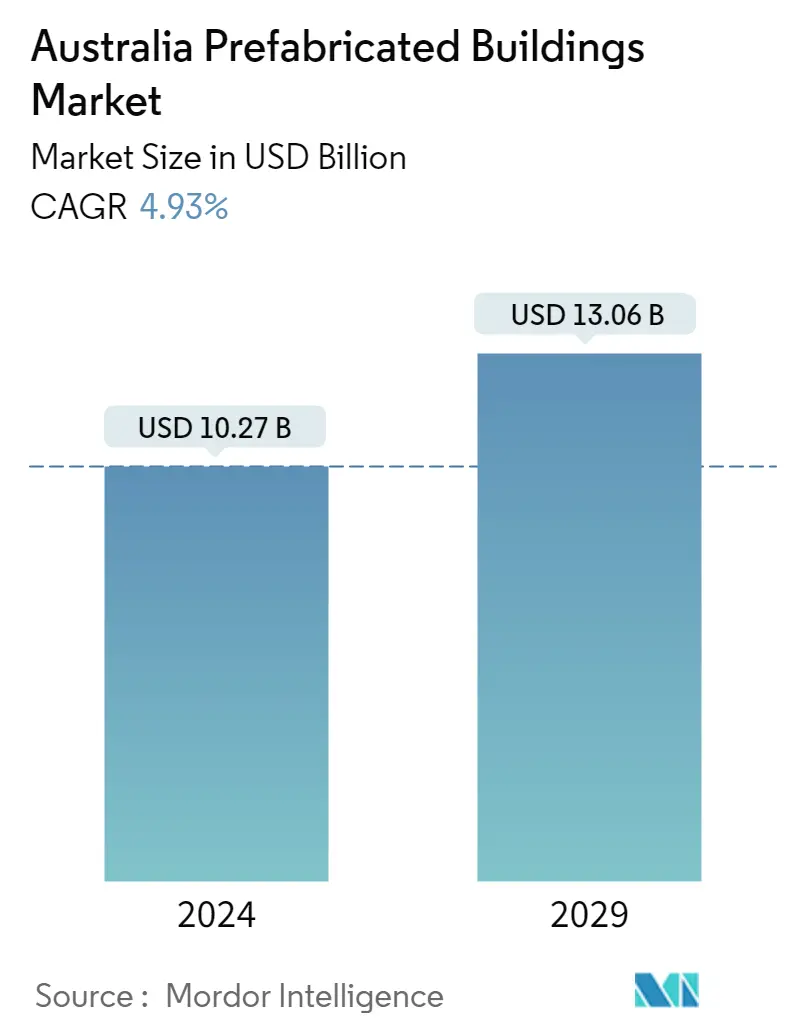
| Study Period | 2020 - 2029 |
| Base Year For Estimation | 2023 |
| Market Size (2024) | USD 10.27 Billion |
| Market Size (2029) | USD 13.06 Billion |
| CAGR (2024 - 2029) | 4.93 % |
| Market Concentration | Low |
Major Players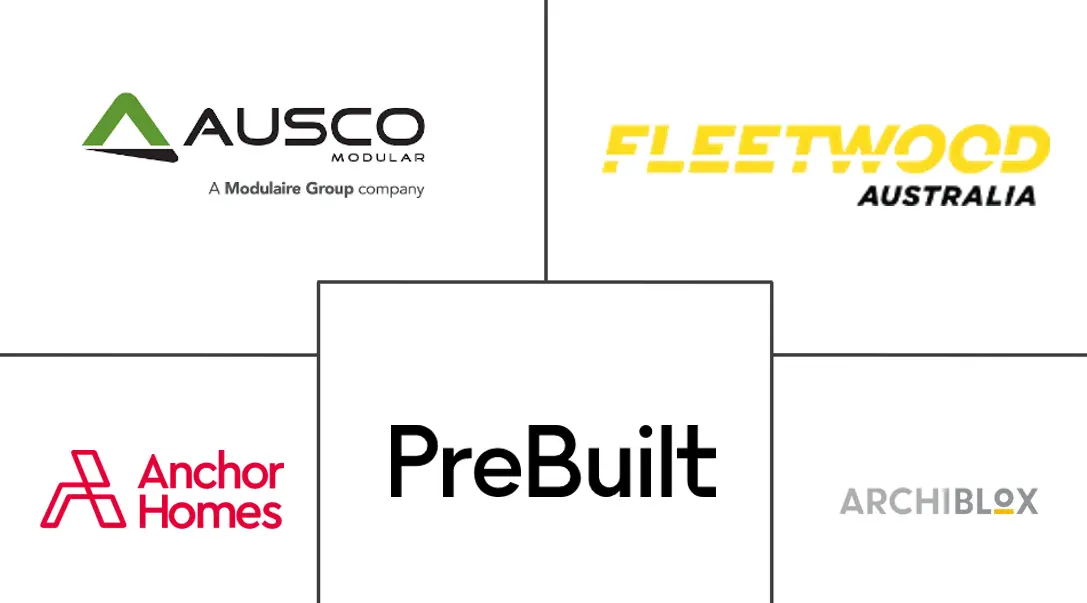
*Disclaimer: Major Players sorted in no particular order |
Australia Prefabricated Buildings Market Analysis
The Australia Prefabricated Buildings Market size is estimated at USD 10.27 billion in 2024, and is expected to reach USD 13.06 billion by 2029, growing at a CAGR of 4.93% during the forecast period (2024-2029).
- The market is primarily driven by the demand for low to mid-rise residential buildings, project homes, and public housing. Increasing awareness about the benefits of prefabricated buildings, such as reduced material waste and less disruption to the surrounding environment, is driving market growth. Revenue in the prefabricated building industry is expected to grow as the rising demand from the government and education sectors has supported the industry during the COVID-19 pandemic. The Australian construction industry has faced severe challenges over the past two decades.
- The adoption of prefabricated solutions in Australia has increased significantly over the past few years. Industry associations and institutions in Australia are launching campaigns to create awareness about the benefits of the prefabricated industry. Leading figures in the Australian industry have recognized the productivity and efficiency gains that advanced manufacturing techniques can offer.
- Due to various causes, including a tight labor market, rising input costs, and increased demand due to government incentives, the construction and building industries have experienced significant price inflation in most states. However, the problems mentioned above are beginning to affect all types of construction. The cost rises traditionally started in residential construction.
- The construction industry has also seen significant delays in finishing projects due to labor shortages and a global supply deficit in several common building materials. The materials include steel, paint, cement, wood, cabinets, and electrical components. Compared to pre-pandemic levels, building material wait times have, at best, doubled and, at worst, increased by more than ten times. Construction projects will experience completion delays and increased cost pressure due to the unfavorable weather affecting the East Coast since the start of the year.
- The adoption of prefabricated solutions in Australia has increased significantly over the past few years. Industry associations and institutions in Australia are launching campaigns to create awareness about the benefits of the prefabricated industry. Many public spaces in Australia, such as new railway stations, police stations, healthcare facilities, and community centers, are now being built using volumetric modular construction and other prefabricated methods with the assistance of the Australian government. The prefabrication construction market in the country is estimated to witness growth.
Australia Prefabricated Buildings Market Trends
Increasing demand for new building construction in Australia driving the market
- Australia is one of the nations with the highest economic growth, and its building sector is flourishing. As public awareness of climate change and other environmental issues continues to rise, more and more people are seeking methods to live sustainably, leading to numerous new construction trends in Australia. One of Australia's most recent construction trends is the preference for modular construction techniques. Off-site construction methods like modular construction include building prefabricated modules in a factory setting before transporting them to the job site.
- The latest official data indicates a significant projected decline in approvals in April. Rising building material and labor costs are pulling down new housing permits. According to the Australian Bureau of Statistics, after a decrease of 19.2% in March 2022, the number of residences permitted in Australia further decreased by 2.4% in April 2022. Approvals for detached homes increased by 0.5% to 10,077, while apartments and townhomes decreased by 6.1% to 4,701.
- As the sector returns to normal after the Home Builder-fueled boom in activity, total approvals are down 32.4% per year, with detached homes and apartments experiencing declines of 33.7% and 28.7%, respectively. The most recent information relates to the housing supply. By 2032, 163,400 dwellings will be necessarily less than what was previously predicted by the National Housing Finance Investment Corporation. The value of new residential construction increased by 4.4% to USD 6.054 billion, while renovations increased by 6.6% to slightly over USD 1 billion. Buildings other than homes saw a 30% decline to USD 4.35 billion.
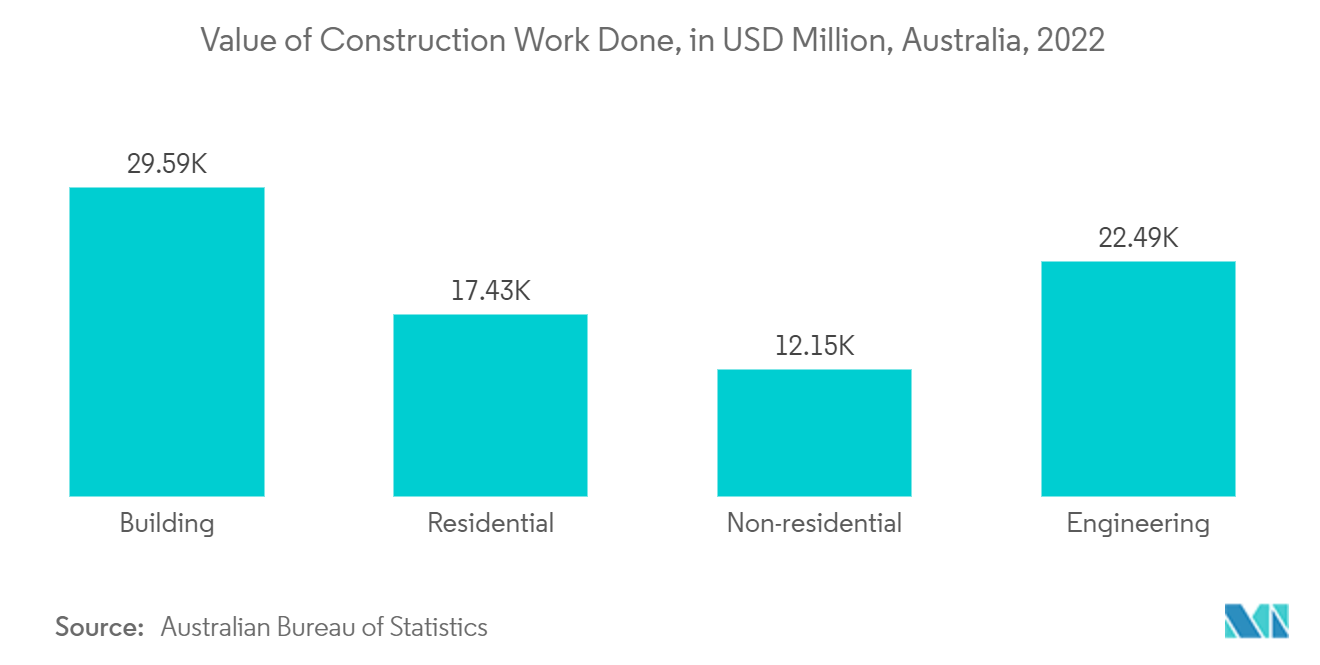
Increasing costs of construction in Australia
- The average cost to build a home in Australia increased by over USD 94,000 in just 15 months. Mortgage holders across the country also feel the effects of the astounding increase. Housing costs also play a significant role in the inflation data that drove the Reserve Bank of Australia to raise interest rates by 1.5% over the past three months. According to an analysis of the most recent building approvals data from the Australian Bureau of Statistics, the average cost of a new house permitted in the country's private sector in May 2022 was USD 413,436.
- Last year, with an increase of 23.7% over the previous 12 months, residential property values experienced their highest yearly growth. Due to historically low borrowing rates and government assistance, Australia's real estate industry has experienced exponential growth. Price increases were seen in all the major capital cities, with Hobart (+29.8%), Canberra (+28.8%), Brisbane (+27.8%), Sydney (+26.7%), and Adelaide (+23.9%) seeing the highest yearly increases. In the last 12 years, Melbourne (+20.0%) has seen the most considerable annual growth, followed by Perth (+15.7%) and Darwin (+13.0%). Due to the increase, Australia's real estate market now has a value of USD 9.9 trillion, with the typical price of residential properties rising by another USD 44,000 to USD 920,100 nationwide.
- The government has been investigating housing affordability and supply due to high prices. The results are anticipated to be public this year. With many Australians being shut out of the real estate market and others facing lifetime loans of millions of dollars, the price increase is causing a housing catastrophe.
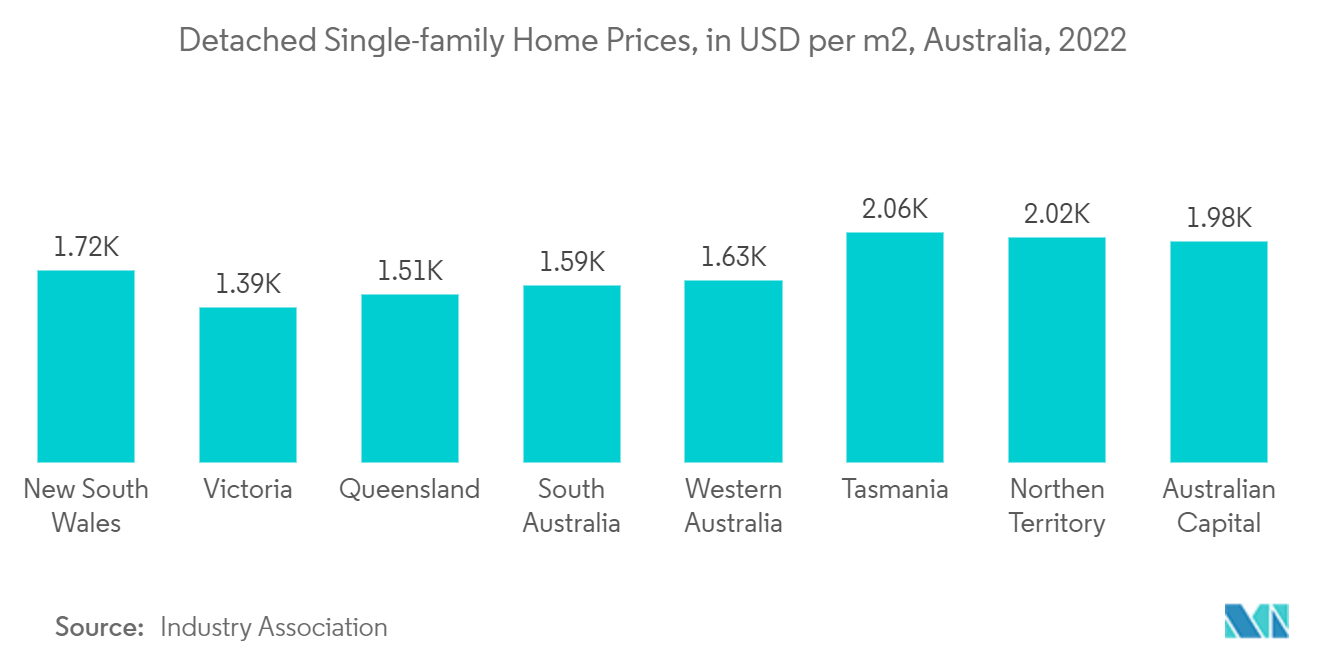
Australia Prefabricated Buildings Industry Overview
The Australian prefabricated buildings market is fragmented and highly competitive due to the presence of global, regional, and local players. Some key players include Ausco Modular Construction Pty Ltd, Fleetwood Australia, Archiblox Pty. Ltd., Anchor Homes, and Prebuilt Commercial. Prefabricated building systems and construction hold a high potential to improve the efficiency and performance of the Australian construction industry in a more sustainable sense. With the market just opening up in the building industry, generating trust and investments in the technology, the market is open to ample opportunities and can witness substantial growth in the coming years.
Australia Prefabricated Buildings Market Leaders
-
Ausco Modular Construction Pty Ltd
-
Fleetwood Australia
-
Archiblox Pty. Ltd.
-
Anchor Homes
-
Prebuilt Commercial
*Disclaimer: Major Players sorted in no particular order
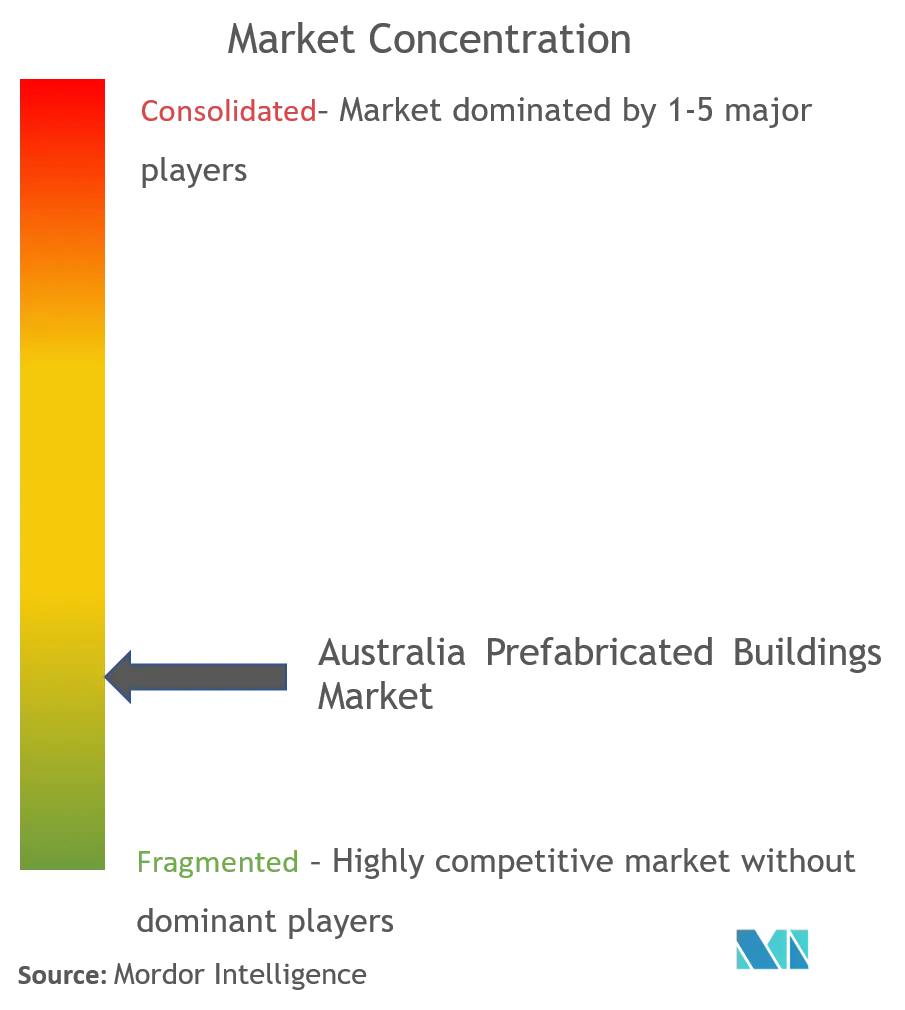
Australia Prefabricated Buildings Market News
- August 2023, Modscape as a participant in QBuild’s Modern Methods of Construction (MMC) Housing Program to address the immediate housing needs in Queensland. This initiative aims to provide affordable and sustainable housing to Queenslanders, from Essential Government Workers to those struggling to find a place to call home. The Queensland Government’s commitment to addressing the housing crisis in the state has led to the prototyping of the QBuild MMC Housing Program. This program aims to build approximately 100 Essential Worker Homes across regional Queensland using modern methods of construction (MMC). The program is expected to provide valuable insights into how MMC can be used to deliver affordable and sustainable housing in regional areas.
- November 2022: Flow2Edge entered a USD 3.5 million consulting, licensing, and distribution agreement with ASX-listed prefab data center provider DXN to export its modules to APAC markets, excluding Australia. The deal follows months of failed acquisition negotiations between the Singapore-based FLOW Digital Infrastructure subsidiary and DXN.
- January 2022: Australian data center firm DXN announced it would build a modular data center for a new Covid-19 quarantine center in Perth, Western Australia. The company announced construction firm Multiplex had contracted it to supply a modular data center and ten communications rooms for AUD 3.5 million (USD 2.5 million). DXN has also delivered at least 18 modular data centers to customers, including Boeing and Covalent Lithium.
Australia Prefabricated Buildings Market Report - Table of Contents
1. INTRODUCTION
- 1.1 Study Assumptions and Market Definitions
- 1.2 Scope of the Study
2. RESEARCH METHODOLOGY
- 2.1 Analysis Methodology
- 2.2 Research Phases
3. EXECUTIVE SUMMARY
4. MARKET INSIGHTS
- 4.1 Current Market Scenario
- 4.2 Technological Trends in the Market
- 4.3 Insights on Supply Chain/Value Chain Analysis of the Market
- 4.4 Brief on Different Structures Used in the Prefabricated Buildings Industry
- 4.5 Cost Structure Analysis of the Prefabricated Buildings Industry
- 4.6 Impact of COVID-19 on the Market
5. MARKET DYNAMICS
- 5.1 Market Drivers
- 5.2 Market Restraints
- 5.3 Market Opportunitites
-
5.4 Industry Attractiveness - Porter's Five Forces Analysis
- 5.4.1 Bargaining Power of Suppliers
- 5.4.2 Bargaining Power of Consumers / Buyers
- 5.4.3 Threat of New Entrants
- 5.4.4 Threat of Substitute Products
- 5.4.5 Intensity of Competitive Rivalry
6. MARKET SEGMENTATION
-
6.1 By Material Type
- 6.1.1 Concrete
- 6.1.2 Glass
- 6.1.3 Metal
- 6.1.4 Timber
- 6.1.5 Other Material Types
-
6.2 By Application
- 6.2.1 Residential
- 6.2.2 Commercial
- 6.2.3 Other Applications (Infrastructure and Industrial)
7. COMPETITIVE LANDSCAPE
- 7.1 Market Concentration Overview
-
7.2 Company Profiles
- 7.2.1 Ausco Modular Construction Pty Ltd
- 7.2.2 Fleetwood Australia
- 7.2.3 Landmark Products Pty Ltd
- 7.2.4 Spanbilt Pty Limited
- 7.2.5 Archiblox Pty. Ltd.
- 7.2.6 Swan Hill Engineering Pty Ltd
- 7.2.7 Black Diamond Modular Buildings Pty Ltd
- 7.2.8 Anchor Homes
- 7.2.9 Strongbuild Manufacturing Pty Ltd
- 7.2.10 Modscape
- 7.2.11 Prebuilt Commercial
- 7.2.12 K.L. Modular Systems Pty. Ltd *
- *List Not Exhaustive
8. FUTURE OF THE MARKET
9. APPENDIX
- 9.1 Marcroeconomic Indicators (GDP breakdown by Sector, Contribution of Construction to Economy, etc.)
- 9.2 Key Production, Consumption, Exports and Import Statistics of Construction Materials
Australia Prefabricated Buildings Industry Segmentation
Prefabrication is the practice of assembling components of a structure in a factory or other manufacturing site and transporting complete assemblies or sub-assemblies to the construction site. A comprehensive background analysis of the Australian Prefabricated Buildings Market, including the assessment of the economy and contribution of sectors in the economy, a market overview, market size estimation for key segments, emerging trends in the market segments, market dynamics and geographical trends, and COVID-19 impact, is covered in the report.
The Australian prefabricated buildings market is segmented by material type (concrete, glass, metal, timber, and other material types) and application (residential, commercial, and other applications (infrastructure and industrial)). The report offers market size and forecast values in (USD) for all the above segments.
| By Material Type | Concrete |
| Glass | |
| Metal | |
| Timber | |
| Other Material Types | |
| By Application | Residential |
| Commercial | |
| Other Applications (Infrastructure and Industrial) |
Australia Prefabricated Buildings Market Research Faqs
How big is the Australia Prefabricated Buildings Market?
The Australia Prefabricated Buildings Market size is expected to reach USD 10.27 billion in 2024 and grow at a CAGR of 4.93% to reach USD 13.06 billion by 2029.
What is the current Australia Prefabricated Buildings Market size?
In 2024, the Australia Prefabricated Buildings Market size is expected to reach USD 10.27 billion.
Who are the key players in Australia Prefabricated Buildings Market?
Ausco Modular Construction Pty Ltd, Fleetwood Australia, Archiblox Pty. Ltd., Anchor Homes and Prebuilt Commercial are the major companies operating in the Australia Prefabricated Buildings Market.
What years does this Australia Prefabricated Buildings Market cover, and what was the market size in 2023?
In 2023, the Australia Prefabricated Buildings Market size was estimated at USD 9.79 billion. The report covers the Australia Prefabricated Buildings Market historical market size for years: 2020, 2021, 2022 and 2023. The report also forecasts the Australia Prefabricated Buildings Market size for years: 2024, 2025, 2026, 2027, 2028 and 2029.
Australia Prefabricated Buildings Industry Report
Statistics for the 2024 Australia Prefabricated Buildings market share, size and revenue growth rate, created by Mordor Intelligence™ Industry Reports. Australia Prefabricated Buildings analysis includes a market forecast outlook to for 2024 to 2029 and historical overview. Get a sample of this industry analysis as a free report PDF download.



